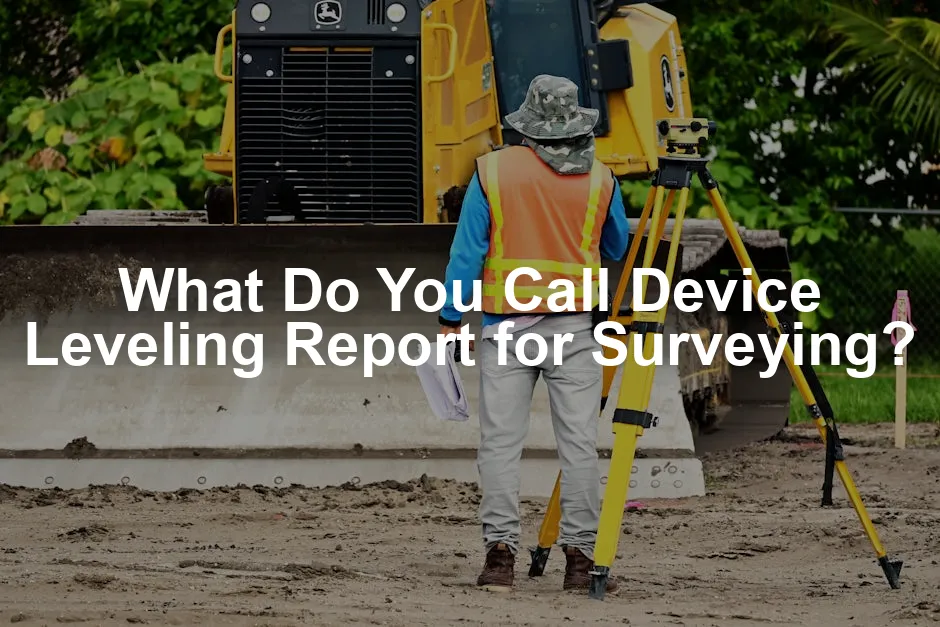Introduction
In the world of surveying, precision is the name of the game, and understanding the terminology is crucial. Enter the elusive “device leveling report,” a document that might sound mundane but is the backbone of accurate surveying. Whether you’re a seasoned surveyor or a curious novice, this guide will break down everything you need to know about this essential report, ensuring that you won’t be left in the dark—or, worse, off-level! From the nuances of device types to the importance of accurate measurements, let’s dig into the world of surveying reports.
Speaking of essential tools, having the right equipment is crucial. If you’re looking to enhance your surveying game, consider investing in a Digital Leveling Instrument. This nifty gadget ensures accuracy in your measurements, making it a must-have for any serious surveyor.

Summary
This comprehensive article explores the intricacies of device leveling reports in surveying. From defining what a device leveling report entails to its significance in various surveying contexts, this guide aims to enlighten readers about the process and its applications. We’ll dive deep into the various types of leveling devices used, the methodologies behind accurate measurements, and the essential terms associated with leveling. Additionally, we will cover the practical applications of leveling reports in construction and civil engineering, highlighting their importance in ensuring structural integrity and project success. By the end of this article, you will not only understand what a device leveling report is but also appreciate its pivotal role in the surveying landscape. Curious about the tools behind this process? Stick around as we unpack the fascinating world of surveying devices and reports!
Now, if you’re looking for a reliable way to document your findings, you might want to check out a Field Book for Surveying. It’s perfect for jotting down all the important details while you’re out in the field, ensuring you won’t forget a thing!

Understanding Device Leveling Reports
A device leveling report is a formal document recording the measurements taken during a leveling survey. Its primary purpose is to ensure accurate data collection, which is crucial for any surveying project. This report acts as a reference, providing essential information about the heights and elevations of various points surveyed.
One of the key components of a device leveling report is the definition of leveling itself. Leveling is a process that determines the elevation differences between points. The report documents these differences, helping surveyors maintain accuracy and consistency throughout their work. The leveling report typically includes necessary details such as the instrument used, the date of measurement, and environmental conditions, all of which can impact the results.
If you’re serious about leveling accuracy, consider investing in a Automatic Leveling Instrument. This tool can save you time and enhance the precision of your surveys, making it a worthy addition to your toolkit.

The significance of device leveling reports cannot be overstated. In construction projects, for example, they ensure foundations are laid correctly, preventing potential structural failures. In civil engineering, these reports serve as a basis for designing infrastructure, ensuring safety and stability. Each report acts as a snapshot of the survey, capturing the precise measurements needed for effective planning and execution.
Key components of a leveling report include:
- Survey Date and Time: Knowing when measurements were taken helps track changes over time.
- Equipment Used: Documenting the specific leveling device ensures that any discrepancies can be traced back to potential equipment issues.
- Measurement Data: This section includes all backsight (BS) and foresight (FS) readings, crucial for calculating reduced levels (RL).
- Environmental Conditions: Weather can influence leveling results, so noting wind speed or temperature is essential.
- Calculated Elevations: The report will summarize the final calculated elevations for all points surveyed, providing a clear overview.
Ultimately, a device leveling report is more than just numbers on a page. It encapsulates the accuracy and precision vital for successful surveying. Understanding its components and significance will empower both new and seasoned surveyors to appreciate the role of these reports in their projects. So, whether you’re measuring the height of a building or the slope of a road, remember: behind every accurate elevation is a meticulous device leveling report!
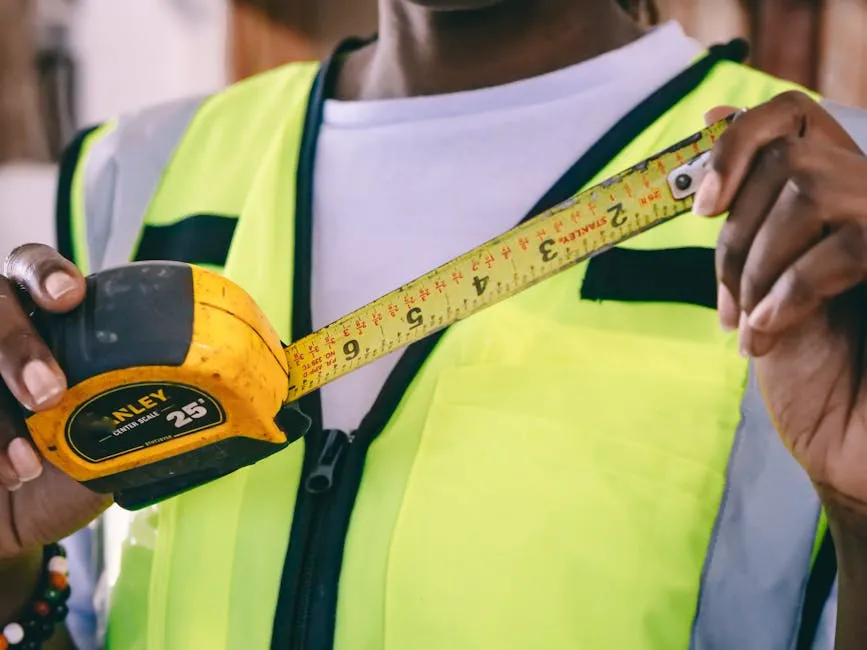
Methods of Leveling in Surveying
Differential Leveling
Differential leveling is the go-to method in surveying. It measures the vertical distance between two points. This process involves a leveling instrument, usually a dumpy or automatic level, and a leveling rod.
Process and Calculations
First, set up the leveling instrument at a known point. Take the backsight (BS) reading on a rod placed at this point. Next, move the rod to the unknown point and take the foresight (FS) reading. The difference in elevation is calculated as:
[ Difference in Elevation = BS – FS ]
If the height of the instrument (HI) is known, the reduced level (RL) of the unknown point can be determined by:
[ RL = HI – FS ]
Example of Use
Imagine surveying a new park. You set your level at point A, reading a BS of 1.5 meters on the rod. At point B, the FS reads 0.8 meters. The elevation difference is 1.5 – 0.8 = 0.7 meters. This tells you that point B is 0.7 meters lower than point A. Simple, right?

Trigonometric Leveling
Trigonometric leveling is a clever approach for those hard-to-reach places. Instead of direct measurements, it uses angles and distances. This method is particularly useful in mountainous or rugged terrains.
When to Use It
Employ trigonometric leveling when the points are too far apart for direct leveling. It’s also handy when obstacles hinder direct sightlines.
Key Formulas
To calculate height differences, use trigonometric relationships. If you know the angle of elevation (α) and the horizontal distance (D), the height (h) can be calculated as:
[ h = D · tan(α) ]
This formula allows surveyors to calculate vertical distances without physically moving closer to the point.
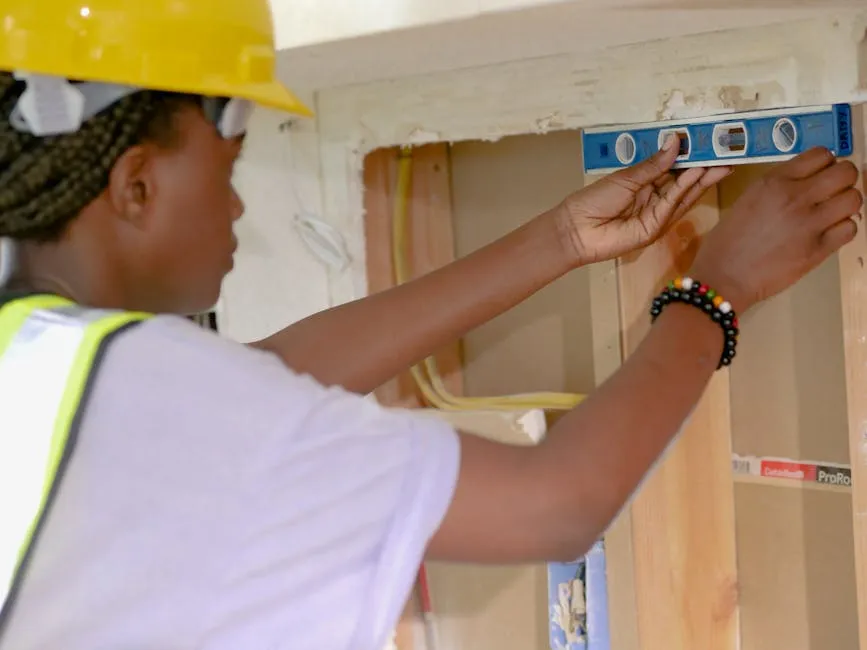
Profile Leveling
Profile leveling is like taking a selfie of the terrain. It involves measuring elevations along a predetermined line. This method helps in understanding the terrain’s slope and is crucial in civil engineering.
Application in Civil Engineering
Engineers use profile leveling to design roads, railways, and pipelines. By mapping out the terrain, they can identify where to cut or fill earth, ensuring smoother transitions and effective drainage.
Cross-Section Leveling
Cross-section leveling is the sidekick to profile leveling. This method measures the terrain perpendicular to the main profile line.
Importance in Topographic Surveys
When creating topographic maps, cross-section leveling helps visualize the land’s features. It provides invaluable data for planning infrastructure projects, ensuring that roads, bridges, and buildings are constructed on stable ground.
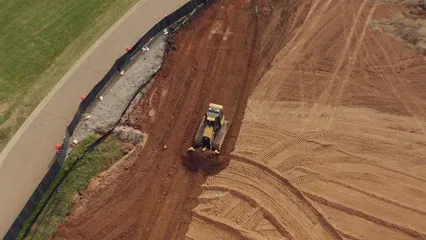
In summary, the methods of leveling in surveying are essential for gathering precise data about the land. From differential to trigonometric, profile to cross-section leveling, each method plays a vital role in ensuring accurate measurements that contribute to successful construction and engineering projects.

Practical Applications of Leveling Reports
Construction Projects
Leveling reports play a significant role in construction projects. They ensure foundation stability, which is crucial for any building. Imagine constructing a towering skyscraper without a solid base. Sounds like a recipe for disaster, right? Leveling reports help avoid such nightmares.
Before laying the foundation, surveyors perform differential leveling. This method measures the elevation difference between various points on the site. The leveling report documents these measurements, ensuring that the foundations are laid on solid, even ground. Without accurate leveling, buildings may settle unevenly, causing structural issues. Who wants a house with a slant? Not anyone looking to sell!

Moreover, leveling reports guide contractors in establishing grades for drainage. Proper water drainage is vital for preventing flooding and other water-related issues. By analyzing the leveling report, builders can plan the landscape to encourage water flow away from the structure, protecting it from damage. And speaking of protection, a Construction Safety Helmet is a must-have for any construction site worker!
Topographic Mapping
Leveling reports are also essential for creating accurate topographic maps. These maps depict the terrain’s shape and elevation, which is particularly useful for land development and environmental studies. Through precise measurements in the leveling report, surveyors can outline hills, valleys, and slopes.

Topographic maps assist in planning projects like roads, parks, and recreational areas. If you’re dreaming of a hiking trail, you better believe that accurate topographic mapping is part of the process. These maps help visualize the landscape and identify potential challenges, such as steep slopes or wetlands.
Additionally, these reports are crucial for disaster preparedness. Accurate topographic data can help predict flood zones and other natural hazards. Knowing where the high and low points are can save lives and property. For those outdoor adventures, a durable Outdoor Backpack can be a lifesaver!

Infrastructure Development
In infrastructure development, leveling reports are indispensable during the planning and design phases. Engineers rely on these reports to ensure that roads, bridges, and other structures are built to appropriate elevations. A well-documented leveling report can prevent costly mistakes and delays.
For example, when constructing a bridge, engineers must consider the clearance above water levels during floods. Leveling reports provide the necessary elevation data to make informed decisions. Without this information, the bridge could end up too low, leading to potential disasters during heavy rains.
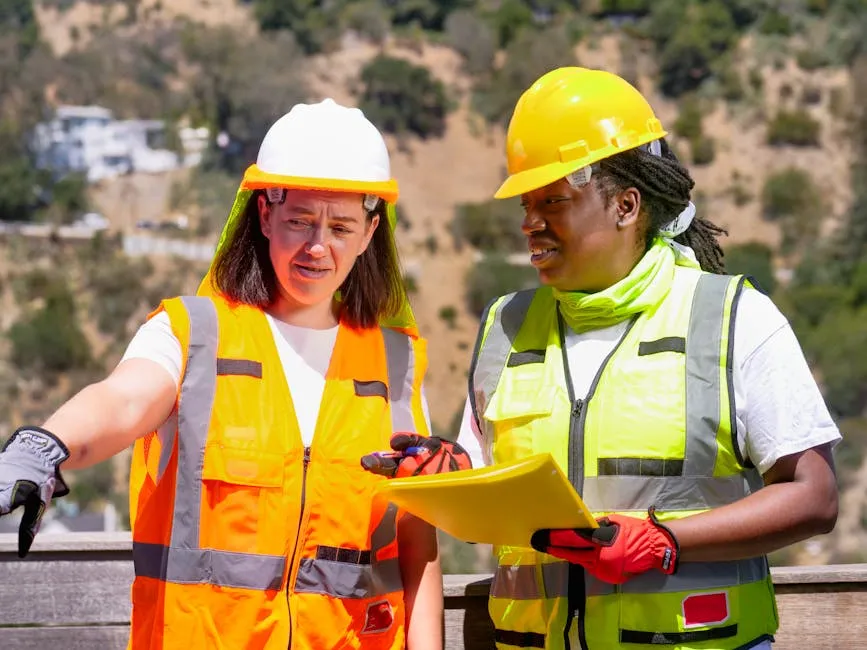
Moreover, leveling reports facilitate the alignment of utilities such as water and sewer systems. Proper elevation ensures that the systems function correctly, preventing backflow and other issues that can arise from improper grading. And while you’re on the site, don’t forget to keep your tools handy! A Multi-Tool for Construction is perfect for all those unexpected situations!
In summary, the practical applications of leveling reports are vast and critical across various fields. From ensuring stable foundations in construction to aiding in disaster preparedness, these reports are the unsung heroes of surveying. The next time you see a well-constructed building or a beautifully designed park, remember that it all starts with an accurate leveling report!

Challenges in Leveling and Reporting
Common Errors in Measurements
Despite the importance of precise leveling, errors can creep in during measurements. Human error is a significant factor. Surveyors may misread the leveling rod or misalign the equipment. Even the slightest mistake can lead to significant discrepancies in the final report.
Instrument calibration is another common challenge. If leveling devices aren’t properly calibrated, they can yield incorrect readings. Regular maintenance and checks are essential to ensure accuracy. For those who want to ensure their tools are always in top shape, consider keeping a Surveying Equipment Maintenance Guide handy!

Environmental Factors Affecting Accuracy
Weather conditions can also impact leveling accuracy. Wind can sway the instrument, and heat can cause atmospheric refraction, leading to misleading measurements. Rain can make the ground unstable, affecting the survey’s reliability. Surveyors must choose optimal conditions for their work, which can be tricky.
Additionally, terrain plays a role. Uneven or unstable ground can make it difficult to set up leveling equipment correctly. Surveyors often have to be creative in these situations, using temporary benchmarks or other methods to ensure precision.
Best Practices for Accurate Reporting
To mitigate these challenges, surveyors should adhere to best practices. Regular training is crucial. Keeping skills sharp helps reduce human error. Additionally, using high-quality instruments can make a world of difference. Digital levels and automated equipment can increase accuracy and reduce the chances of misreading. Consider a Laser Distance Measurer to help streamline your measurements!
Another best practice is to conduct multiple measurements. Taking several readings over the same point can help identify discrepancies, leading to more accurate leveling reports.
Incorporating these practices ensures that leveling reports remain reliable and accurate, ultimately supporting successful construction and surveying projects.
Conclusion
In conclusion, device leveling reports are more than just numbers; they are the backbone of accurate surveying. We’ve explored their critical applications in construction and infrastructure development, where they ensure stability and precision. From creating topographic maps to ensuring proper drainage, leveling reports are essential in various fields.
Understanding the challenges in leveling and reporting is equally important. Recognizing common errors, environmental factors, and best practices helps improve accuracy and reliability.
As we move forward, the importance of accurate leveling reports in surveying cannot be overstated. They play a pivotal role in our built environment, affecting everything from our homes to our roads. So, the next time you admire a well-constructed building or a beautifully planned park, remember the meticulous work that went into ensuring its stability. Accurate leveling reports might not be glamorous, but they are the unsung heroes behind our infrastructure’s success. And for those who love the great outdoors, don’t forget to grab a pair of Professional Grade Binoculars for those scenic views!
FAQs
What is the difference between backsight and foresight?
Backsight (BS) and foresight (FS) are critical concepts in leveling. Backsight refers to the first reading taken on a known elevation point, helping establish a reference. Think of it as your surveyor’s way of checking the scoreboard before the game starts. It’s essential for ensuring that the leveling process kicks off on solid ground. Foresight, on the other hand, is the final reading taken before moving to a new position. This is where the surveyor measures the elevation of the point under investigation. It’s like the final score of the game—crucial for determining how well you did! Together, these readings allow the surveyor to calculate the height difference between points, ensuring accuracy in the leveling report.
How often should leveling reports be updated?
Leveling reports should be updated regularly, especially for ongoing projects. For construction sites, a weekly update is often best. This ensures any ground movements or changes in conditions are documented. Imagine a house settling unevenly—nobody wants that surprise when it’s too late! In civil engineering projects, updates may vary based on the project’s scale and complexity. If significant changes occur, like alterations in ground conditions or the addition of new structures, immediate updates are necessary. Keeping your leveling reports current is like keeping your car’s oil fresh—vital for smooth operation and avoiding bigger problems down the road.
What are the consequences of inaccurate leveling?
Inaccurate leveling can lead to disastrous outcomes. Imagine constructing a building on an uneven foundation; it may lead to cracks, structural failure, or, worse, collapse. Not exactly the ideal outcome for any architect or homeowner! Inaccurate leveling also affects drainage systems. If elevations are incorrect, water may flow toward the structure instead of away from it, leading to flooding and other water-related issues. Additionally, inaccurate reports can delay projects, inflate costs, and damage reputations. In the world of surveying, precision is paramount, and the stakes are high. So, always double-check those readings—your future (and that of your project) depends on it!
To enhance your understanding of effective data handling, you can explore best practices for using Israel Central Bureau of Statistics data visualization.
Please let us know what you think about our content by leaving a comment down below!
Thank you for reading till here 🙂
All images from Pexels

